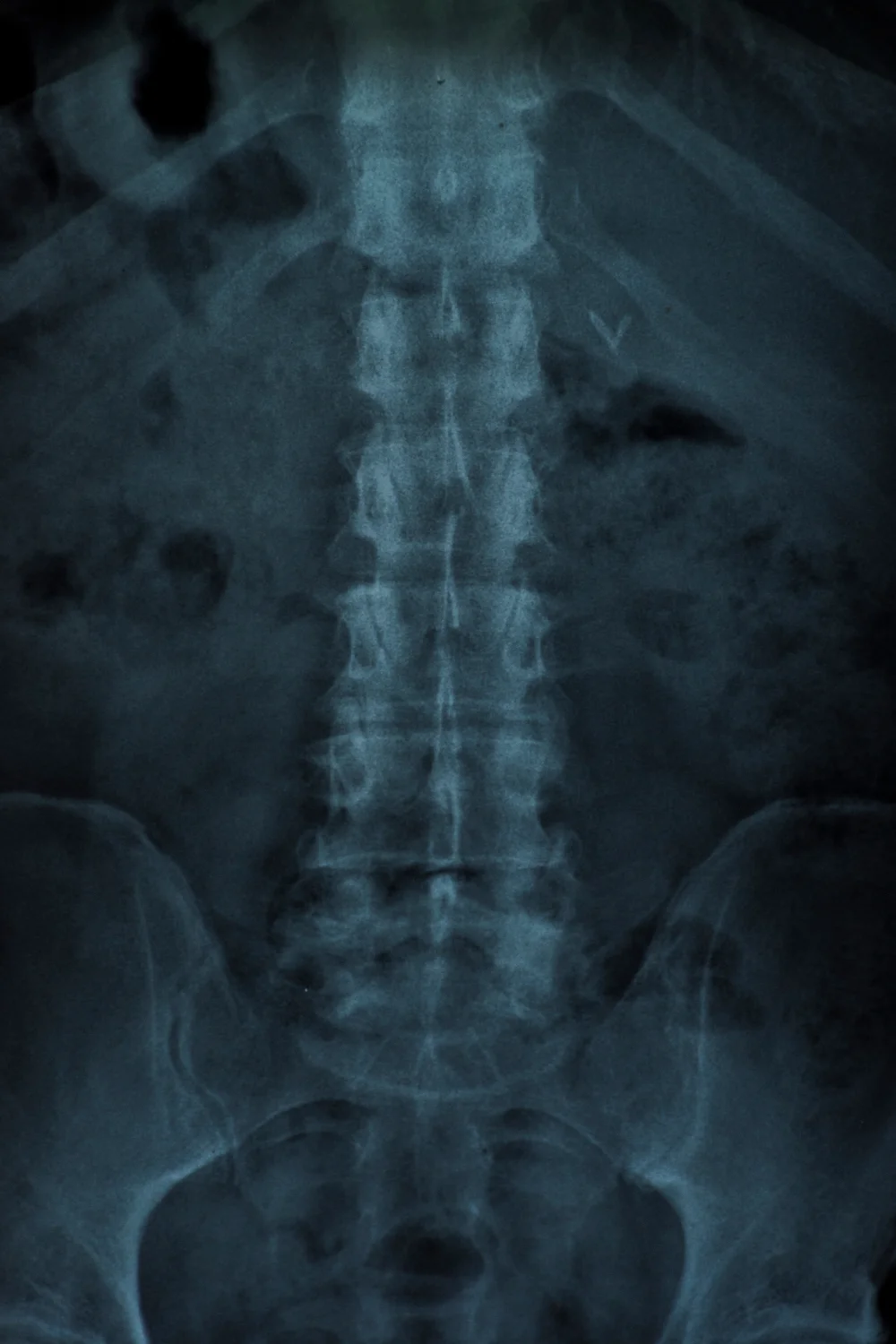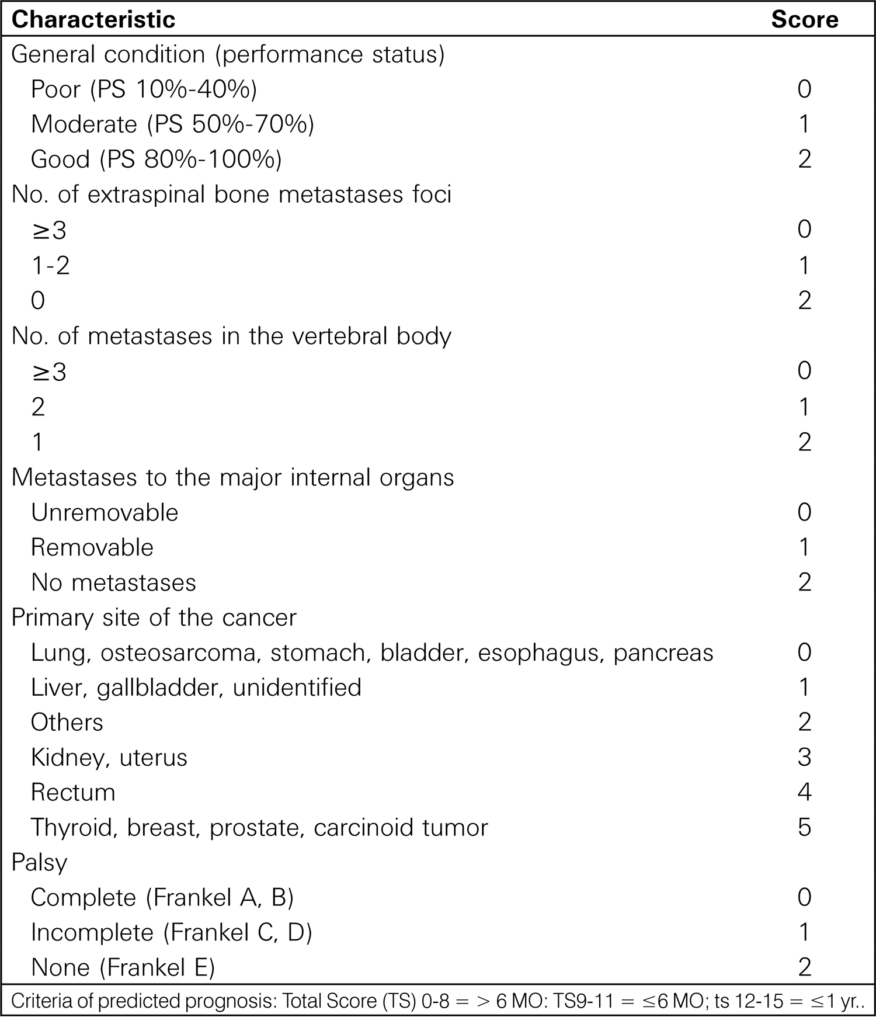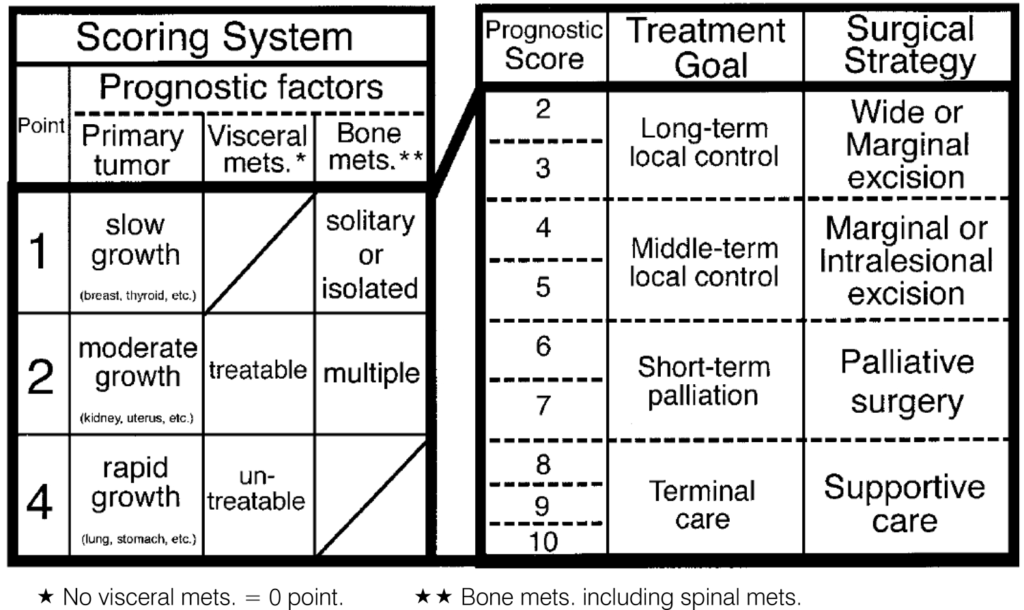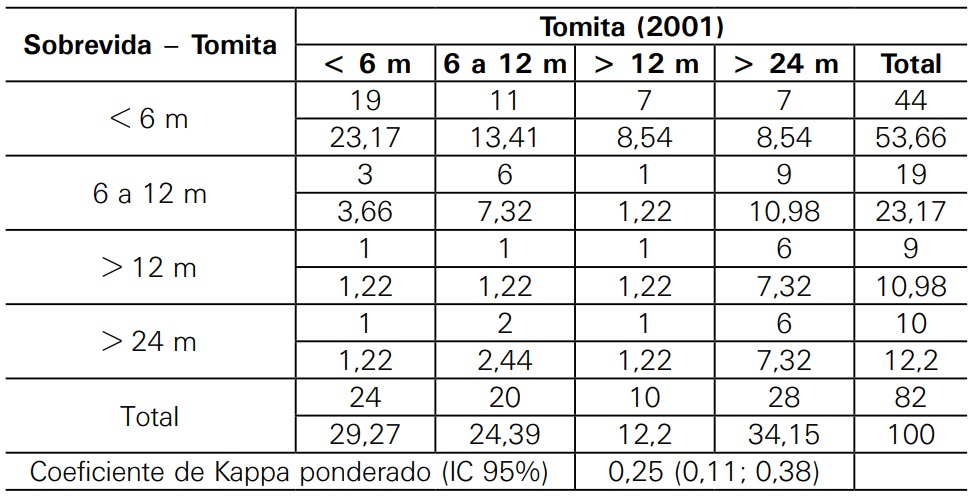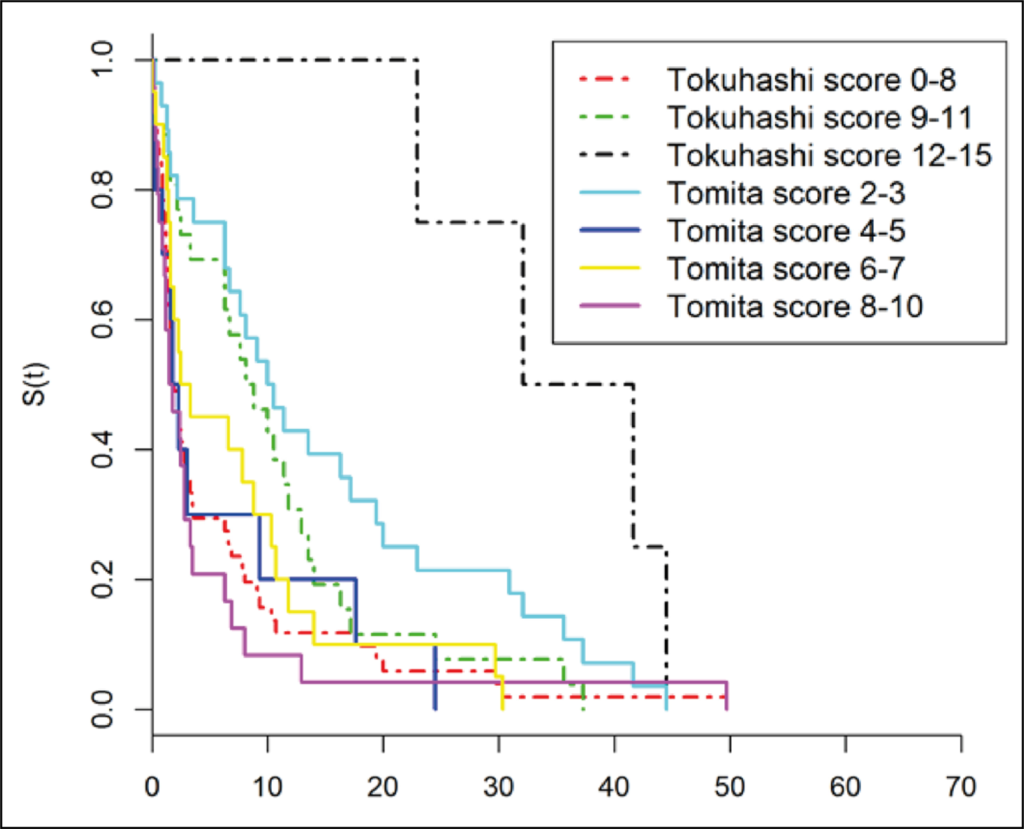A COMPARISON OF THE TOMITA AND TOKUHASHI SCORES IN SPINAL METASTASIS
COMPARAÇÃO DAS ESCALAS DE TOMITA E TOKUHASHI NA METÁSTASE VERTEBRAL
COMPARACIÓN DE LAS ESCALAS DE TOMITA Y TOKUHASHI EM LA MESTÁSTASIS VERTEBRAL
Original Article / Artigo Original / Artículo Original
1. Universidade de São Paulo. Ribeirão Preto School of Medicine. Department of Orthopedics and Anesthesiology. Ribeirão Preto, SP, Brazil.
2. Clínica da Unimed. Unidade Limeira. Limeira, SP, Brazil.
3. Universidade de São Paulo. Ribeirão Preto School of Medicine. Clinical Oncology Division. Medical Imaging Department. Hematology and Clinical Oncology. Ribeirão Preto, SP, Brazil
4. Universidade de São Paulo. Ribeirão Preto School of Medicine. Department of Orthopedics and Anesthesiology. Ribeirão Preto, SP. Brazil
Índice
ABSTRACT
Objective: To compare Tokuhashi and Tomita scores in patients with epidural spinal metastasis who underwent surgical treatment. Methods: A retrospective evaluation of 103 patients with spinal metastasis and epidural compression who underwent surgical treatment. An analysis was performed of agreement between the survival rates observed in the study sample and the survival rate estimated by the Tomita and Tokuhashi scales. Results: The overall accuracy was 39.03% for the Tomita scale and 61.75% for the Tokuhashi scale. Fair agreement (0.38 weighted Cohen’s Kappa coefficient) was observed between patient survival and the Tokuhashi score, and slight agreement (0.25 weighted Kappa coefficient) for the Tomita score. The agreement for both scales was higher for patients with less than six months’ survival, with general accuracy of 79.17% for the Tomita and 70.59% for the Tokuhashi scoring system. Conclusion: There was fair and slight agreement between the Tokuhashi and Tomita scores with patient survival group. The agreement was higher for patients with less than six months’ survival. Level of evidence III; Comparative retrospective study
Keywords: Spinal Neoplasms; Neoplasm Metastasis; Life Expectancy; Outcome Assessment, Health Care.
RESUMO
Objetivo: Comparar as escalas de Tokuhashi e Tomita em pacientes com metástase epidural da coluna vertebral submetidos a tratamento cirúrgico. Métodos: Avaliação retrospectiva de 103 pacientes com metástase da coluna vertebral e compressão epidural submetidos o tratamento cirúrgico. Foi realizada uma análise de concordância entre as taxas de sobrevida observadas na amostra do estudo e as taxas de sobrevida estimada pelas escalas de Tomita e Tokuhashi. Resultados: A acurácia geral para a escala Tomita foi de 39,03% e de 61,75% para a escala Tokuhashi. Foi observada concordância razoável (coeficiente Kappa de Cohen ponderado de 0,38) entre a sobrevida do paciente e o escore de Tokuhashi, e concordância baixa (coeficiente Kappa ponderado de 0,25) para o escore de Tomita. A concordância entre as duas escalas foi maior para pacientes com sobrevida inferior a seis meses, com acurácia de 79,17% para a escala Tomita e 70,59% para a escala Tokuhashi. Conclusões: Foi observada concordância razoável e baixa entre os escores de Tokuhashi e Tomita no grupo de sobrevida dos pacientes. A concordância foi maior nos pacientes com sobrevida inferior a seis meses. Nível de evidência III; Estudo retrospectivo comparativo.
Descritores: Neoplasias da Coluna Vertebral; Metástase Neoplásica; Expectativa de Vida; Avaliação de Resultados em Cuidados de Saúde.
RESUMEN
Objetivo: Comparar las escalas de Tokuhashi y Tomita en pacientes con metástasis epidural de la columna vertebral sometidos a tratamiento quirúrgico. Métodos: Evaluación retrospectiva de 103 pacientes con metástasis de la columna vertebral y compresión epidural, sometidos a tratamiento quirúrgico. Fue realizado un análisis de concordancia entre las tasas de sobrevida observadas en la muestra del estudio y las tasas de sobrevida estimada por las escalas de Tomita y Tokuhashi. Resultados: La precisión general para la escala Tomita fue de 39,03% y de 61,75% para la escala Tokuhashi. Fue observada concordancia razonable (coeficiente Kappa de Cohen ponderado de 0,38) entre la sobrevida del paciente y el score de Tokuhashi, y concordancia baja (coeficiente Kappa ponderado de 0,25) para el score de Tomita. La concordancia entre las dos escalas fue mayor para pacientes con sobrevida inferior a seis meses, con precisión de 79,17% para la escala Tomita y del 70,59% para la escala Tokuhashi. Conclusiones: Fue observada concordancia razonable y baja entre los scores de Tokuhashi y Tomita en el grupo de sobrevida de los pacientes. La concordancia fue mayor en los pacientes con sobrevida inferior a seis meses. Nivel de evidencia III; Estudio retrospectivo comparativo.
Descriptores: Neoplasias de la Columna Vertebral; Metástasis de la Neoplasia; Esperanza de Vida; Evaluación de Resultado en la Atención
de Salud.
Study conducted at: Hospital das Clínicas of the Ribeirão Preto School of Medicine – USP.
Correspondence: Helton Luiz Aparecido Defino. Department of Orthopedics and Anesthesiology of the Ribeirão Preto School of Medicine – USP- hladefin@fmrp.usp.br
INTRODUCTION
The spine is the most common site of bone mestastasis. The tumors most likely to cause bone metastasis are, in order of incidence: prostate, breast, kidney, lung and thyroid cancer.1 , 2 Epidural or vertebral metastasis occurs in 94.48% of patients, and intradural extramedullary (5-6%) or intramedullary metastasis (0.5%) are rare.3 , 4 Spinal cord compression (SCC) is the most serious complication, affecting 20% of patients.5 – 6
The widespread availability of advanced imaging, and the improvement in survival rates with the use of targeted therapies, has contributed to increasing the magnitude of the problem related to spinal metastasis.3 – 6 The number of patients who undergo surgery, and the survival rates, are expected to increase.7
Surgical treatment of spinal metastasis began to be accepted and widely used after the report of a controlled trial by Patchell et al., which showed that surgery followed by radiotherapy provided better outcomes, compared to radiotherapy alone, in patients with a life expectancy of more than three months.8 Patchell’s report influenced the indication for surgical treatment of spinal metastasis, and adopted the threshold of life expectancy that has also influenced the decision for surgical indication.8
The goal of surgical treatment of spinal metastasis is pain relief, restoration or preservation of neurological function, stabilization of spinal segment, and improvement of health-related quality of life.6 , 7 The prognosis of patients with epidural metastasis is not promising and is difficult to predict. But predicting survival is extremely important in the choice of treatment. The primary tumor and a team approach can assist in the treatment decision. Scoring systems have been devised to predict patient survival and assist in this decision.3 , 5
Tokuhashi9 proposed a scoring system in 1989, and a revised version was presented in 2005.10 The score considers the patient’s clinical condition based on the Karnofsky Performance Status Scale (KPS),11 the number of bone metastases in the spine, the number of metastases in the axial skeleton, whether there is resectable tumor in other organs, the degree of paralysis (according to the Frankel scale) and the primary tumor site. (Figure 1)
Tomita in 2001 proposed another scoring system to predict survival in patients with spinal metastasis. This scoring system ( Figure 2) is composed of three parameters based on the speed of tumor growth, the presence or absence of visceral metastases, and the number of metastatic bone lesions.12
The Tokuhashi and Tomita scores are intended to predict the patient’s survival prognosis, and are widely used for spinal metastasis treatment decisions. These scores provide guidance on the need for more aggressive surgery, palliative surgery or no surgery, according to the patient’s predicted survival prognosis.9 – 13
The goal of this study was to retrospectively compare the Tokuhashi and Tomita scoring system to predict patient survival in our patients who underwent surgical treatment for epidural spinal metastasis.
METHODS
The study was approved by the local IRB – no. 6513/2015. A retrospective review and collection of data were performed for 103 patients with spinal metastasis and epidural compression who underwent surgical treatment between March 2009 and August 2015, in the Department of Orthopedics and Anesthesiology of the Ribeirão Preto School of Medicine, São Paulo University.
The inclusion criteria were patients over 18 years old with a diagnosis of spinal cord compression who were submitted to surgery to treat this complication, and who had a diagnosis of metastatic solid malignant tumor. The exclusion criteria were patients who had previously undergone surgery for spinal decompression, patients with a diagnosis of hematological malignancy, and patients with solid metastatic neoplastic disease whose spinal compression was not confirmed after anatomopathological evaluation of the surgical material.
All enrolled patients underwent open posterior fixation using a pedicle screw based system associated with decompressive laminectomy. Corpectomy was also performed in patients for whom anterior column reconstruction was required.
The survival time was evaluated using the Kaplan-Meier curves, and the weighted Kappa coefficient was used to compare patient survival and predicted survival according to the Tokuhashi and Tomita scoring systems.
RESULTS
A total of 103 patients were enrolled in the study, with forty female patients (39.88%) and 63 male patients (61.17%). The patients’ ages at the time of spinal decompression surgery ranged from 18 to 91 years, with a calculated average age of 55.28±15.79 years for both sexes: 56.83±16.26 years for the males and 52.85±14.89 for the females. (Table 1) The distribution of the primary tumor sites is illustrated in table 1. The most frequent tumor was breast cancer (26.1%), followed by prostate cancer (22.33%).
Table 1
Distribution of primary tumor sites (HCFMRP-USP 2009 to 2015)
The clinical picture and outcomes are illustrated in Table 2 . According to the Karnofsky Performance Status (KPS)11 classification, only 4 patients had KPS above 80% (1 patient with KPS = 100% and 3 with KPS = 90%). Most patients undergoing spinal decompression surgery were classified before the surgical procedure with KPS of between 60-70%, n = 33 and n = 34, respectively. In the sample of 103 patients, this clinical data could not be obtained for only 2 of patients (2%).
Table 2
Clinical characteristics and outcomes (HCFMRP-USP 2009 to 2015).
The weighted Kappa coefficient was used to analyze the agreement between the Tokuhashi10 and Tomita scales12 ( Table 3 and 4 ). The maximum value of this coefficient is 1, which denotes perfect agreement, whereas 0 denotes equal agreement generated by chance. A coefficient of 0.38 (fair) was observed between the Tokuhashi scoring systems and the survival of the evaluated group of patients and 0.25 (slight) for the Tomita scale. The general accuracy (sum of the correct percentage) was 39.03% for the Tomita scale and 61.73% for the Tokuhashi scale. Considering only patients with survival < 6 months, the accuracy was 79.17% for the Tomita scale and 70.59% for the Tokuhashi scale.
A comparison of survival between the Tokuhashi and Tomita scoring systems was performed using the Kaplan-Meier survivorship curve, with a significance level of p<0.05. The best correlation between both scoring systems was observed in patients with high scores and predicted survival of more than 12 months. (Figure 3)
DISCUSSION
The general accuracy for predicting survival in our patients was 39.03% for the Tomita scoring system and 61.73% for the Tokuhashi scoring system. The agreement was fair (weighted Kappa coefficient 0.38) for the Tokuhashi scale and slight (weighted Kappa coefficient 0.25) for the Tomita scale, showing that the prognostic scores of both scales was not accurate in relation to survival of the group. However, a higher agreement was observed for patients with less than six months survival for both scales. The correlation between the prognosis of the Tomita and Tokuhashi scales was high only for patients with predicted survival of more than 12 months.
In addition to the accuracy calculation, we also performed an agreement analysis, as this determines the ability to measure identical results applied to the same subject/phenomenon, whether by different instruments, by the same instrument at different times, by different evaluators, or by a combination of these. Accuracy is a descriptive measure, as it considers only the sum of the percentages of correctness. The concordance analysis of our study showed coefficients of 0.38 and 0.25 for the Tomita and Tokuhashi scoring systems, respectively. Therefore, these data can only suggest that there is slight agreement between the actual survival of the study population and the estimated survival by both prognostic scales.14 However, accuracy among patients with survival of less than 6 months was higher, with 79.17% for the Tomita and 70.59% for the Tokuhashi.
The number of patients undergoing surgery for spinal metastasis has increased as a consequence of advances in oncological treatment.2 Favorable surgical outcomes in patients with epidural metastasis has been reported, and surgical treatment is encouraged for patients with spinal metastasis and a moderate to good prognosis.1 , 3 , 15 , 16 However, it is still difficult to choose the best treatment option, and survival scores were developed to help treatment decision.3 , 4 The Tokuhashi score is widely recognized, and has reported predictive accuracy ranging from 51% to 88%. However several reports consider it to be suboptimal.17 – 21 Contrary to the findings of our study, Zoccali et al.21 report that the Tokuhashi score is more useful in patients with a good prognosis, and less helpful in patients with less than one year survival.19 , 22
Tomita score requires data readily accessible to the majority of clinicians and it continues to play a role in the clinical decision.23 Several comparisons between the Tohuhashi and Tomita scores were reported, and found the Tokuhashi score to be superior.21 , 24 , 25 The Tomita score is patient-centered, and places emphasis on the biology of the primary tumor, which would explain why it maintains predictive values even when specific tumor subtypes are evaluated.21 , 26
The primary tumor type, the patient’s general medical condition, and the level of metastasis are the main factors in most survival scores, but each of these components has unique weakness (Chen). Some tumors, like breast cancer, display variation in the natural history according to hormone receptor status.23 , 26 , 27 All these features present a challenge for scoring systems, if they are to be clinically user friendly and include all the nuances of tumor subtypes.24 The evolution in oncological and surgical treatment of spinal metastasis should also be considered in the analysis of the current tumor scoring system.23 , 28 Differences in patient group and treatment should also be considered in the comparison. Although the Tokuhashi and Tomita scoring systems fail to differentiate medium and long term prognostic groups, and vary from one patient population to another, they are still the two most widely-used systems, despite the introduction of a new scoring system. Compared to Bechara et al.,29 the overall accuracy was lower for Tomita (39.03%) and higher for Tokuhashi (61.73%).
The reported accuracy of the Tomita and Tokuhashi scales for predicting patient survival in multiple myeloma is low, and considering the reports, we have not enrolled myeloma multiple patients with spinal lesion in our study.28
Our findings are in accordance with Aoude,3 who reports that both scores are accurate in differentiating patients with poor prognoses. It was not clear whether both scores would be of value for patients with good or moderate prognoses. We have not based our indication for surgical treatment exclusively on any one scoring system. The choice of treatment also takes into consideration the overall clinical picture, pain, neurological deficit, and spine stability. The overall results of our patients showed a significant improvement in neurological deficit, pain and function. However it is still a challenge to identify the patient with spinal metastasis and epidural compression that would be a good candidate for surgical treatment and would have a significant improvement.
We observed low agreement between the Tomita and Tokuhashi scores and the survival of our patients, except in patients with less than six months’ survival. The prognostic factors for survival varied substantially, according to the primary tumor combined with negative factors.4 , 7 Although scales have been devised for survival of patients with spinal metastasis, there is a lack of evidence related to predictors of neurologic, functional and quality of life outcomes for patients with spinal metastasis.
CONCLUSION
The coefficient of agreement between patient survival and survival estimated by the modified Tomita and Tokuhashi scores was not substantial. Higher accuracy was observed in both scores for patients with less than six months’ survival.
CONTRIBUTION OF THE AUTHORS: Each author made significant individual contributions to this manuscript. PBMC and HLAD were the main contributors to the writing of the manuscript. HLAD and HRC performed the surgery, followed up the patients and gathered clinical data. PBMC and FMP evaluated the data from the statistical analysis. PBMC and FMP performed the bibliographic search and revision of the manuscript, and contributed to the intellectual concept of the study.
REFERENCES
1. Wong DA, Fornasier LV, Macnab I. Spinal metastasis: The obvious, the occult, and the impostors. Spine J. 1990;15(1):1-4.
2. Mundy GR. Metastasis to bone: causes, consequences and therapeutic opportunities. Nat Rev Cancer. 2002;2(8):584-93.
3. Aoude A, Amiot LP. A comparison of the modified Tokuhashi and Tomita scores in determining prognosis for patients afflicted with spinal metastasis. Can J Surg. 2014;57(3):188-93.
4. Stutcliff P, Connock M, Shyangdan D, Court R, Kandala NB, Clarke A. A systematic review of evidence on malignant spinal metastases: natural history and technologies for identifying patients at high risk of vertebral fracture and spinal cord compression. Health Technol Assess. 2013;17(42):1-247.
5. Schaberg J, Gainor BJ. A profile of metastatic carcinoma of the spine. Spine (Phila Pa 1976). 1985;10(1):19-20.
6. Barzilai O, McLaughlin L, Amato MK, Reiner AS, Ogilvie SQ, Lis E, et al. Predictors of quality of life improvement after surgery for metastatic tumors of the spine: prospective cohort study. Spine J.
2018;18(7):1109–15.
7. Nater A, Martin AR, Sahgal A, Choi D, Fehlings MG. Symptomatic spina metastasis: A systematic literature review of the preoperative prognostic factors for survival, neurological, functional and quality of life in surgically treated patients and methodological recommendations for prognostic studies. Plos One. 2017;12(2):e0171507.
8. Patchel RA, Tibbs PA, Regine WF, Payne R, Saris S, Kryscio RJ. Direct decompressive surgical resection in the treatment of spinal cord compression caused by metastatic cancer: a randomised trial. Lancet. 2005;366(9486):643-8.
9 – Tokuhashi Y, Kawano H, Ohsaka S, Matsuzaki H, Toriyama S. A scoring system for preoperative evaluation of the prognosis of metastatic spine tumor (a preliminary report). Nihon Seikeigeka Gakkai Zasshi.1989;63(5):482-9.
10. Tokuhashi Y, Matsuzaki H, Oda H, Oshima M, Ryu J. A revised scoring system for preoperative evaluation of metastatic spine tumor prognosis. Spine (Phila Pa 1976). 2005;30(19):2186-91.
11. Karnofsky DA, Young CW. Comparative aspects of the pharmacology of the antimetabolites. Fed Proc.1967;26(4):1139-45.
12. Tomita K, Kawahara N, Kobayashi T, Yoshida A, Murakami H, Akamaru T. Surgical strategy for spinal metastases. Spine (Phila Pa 1976). 2001;26(3):298-306.
13. Mereles ME, Estefan MM, Petracchi MG, Bassani JE, Gruenberg M, Solá CA. En bloc vertebral resection for primary and metastatic spine tumors. Coluna/Columna. 2020;19(1):79-83.
14. Landis RJ, Koch GG. The measurement of observer agreement for categorical data. Biometrics. 1977;33(1):159-74.
15. Klekamp J, Samii H. Surgical results for spinal metastases. Acta Neurochir (Wien). 1998;140(9):957-67.
16. Bauer HC. Posterior decompression and stabilization for spinal metastases. Analysis of sixtyseven consecutive patients. J Bone Joint Surg Am. 1997;79(4):514-22.
17. Tabouret E, Cauvin C, Fuentes S, Esterni B, Adetchessi T, Salem N, et al. Reassessment of scoring systems and prognostic factors for metastatic spinal cord compression. Spine J. 2015;15(5):944-50.
18. Park S, Lee C, Chung S, Lee K. How accurately can Tokuhashi score system predict the survival in the current practice for spinal metastases? Prospective analysis of consecutive 145 patients between 2007 and 2013. J Spinal Disord Tech. 2015;28(4):E219-24.
19. Gakhar H, Swamy GN, Bommireddy R, Calthorpe D, Klezl Z. A study investigating the validity of modified Tokuhashi score to decide surgical intervention in patients with metastatic spinal cancer. Eur Spine J. 2013;22(3):565-8.
20. Hernandez-Fernandez A, Vélez R, Lersundi-Artamendi A, Pellisé F. External validity of the Tokuhashi score in patients with vertebral metastasis. J Cancer Res Clin Oncol.2012;138(9):1493-500.
21. Majeed H, Kumar S, Bommireddy R, Klezl Z, Calthorpe D. Accuracy of prognostic scores in decision making and predicting outcomes in metastatic spine disease. Ann R Coll Surg Engl. 2012;94(1):28-33.
22. Zoccali C, Skoch J, Walter CM, Torabi M, Borgstrom M, Baaj AA. The Tokuhashi score: effectiveness and pitfalls. Eur Spine J. 2016;25(3):673-8.
23. Caasidy JT, Baker JF, Lenehan B. The role of prognostic scoring system in assessing surgical candidacy for patients with vertebral metastasis: a narrative review. Global Spine J. 2018;8(6):638-51.
24. Leithner A, Radl R, Gruber G, Hochegger M, Leithner K, Welkerling H, et al. Predictive value of seven preoperative prognostic scoring systems for spinal metastases. Eur Spine J. 2008;17(11):1488-95.
25. Feng JT, Yang XG, Wang F, Hua KC, Liu YH, Hu YC, et al. Prognostic discrepancy on overall survival between ambulatory and nonambulatory patients with metastatic spinal cord compression. World Neurosurgery. 2019;121:e322-32.
26. Wang M, Jensen AB, Morgen SS, Wu CS, Sun M, Li H, et al. Survival analysis of breast cancer subtypes in patients with spinal metastases. Spine (Phila Pa 1976). 2014;39(19):1620-7.
27. Mollahoseini R, Farhan F, Khajoo A, Jouibari MAM, Gholipour F. Is Tokuhashi score suitable for evaluation of life expectancy before surgery in Iranian patients with spinal metastases? J Res Med Sci. 2011;16(9):1183-8.
28. Avanzi O, Landim E, Meves R, Caffaro MFS, Lima MV. Fratura na coluna vertebral por mieloma múltiplo: correlação entre sobrevida e índices de Tomita e Tokuhashi. Coluna/Columna. 2008;8(1):73-9.
29. Bechara AHS, Rosa AF, Risso Neto MI, Tebet MA, Veiga IG, Pasqualini W, et al. Correlation between actual survival and Tokuhashi and tomita scores in spine metastases. Coluna/Columna. 2015;14(2):138-43.

This is an Open Access article distributed under the terms of the Creative Commons Attribution Non-Commercial License which permits unrestricted non-commercial use, distribution, and reproduction in any medium provided the original work is properly cited.


